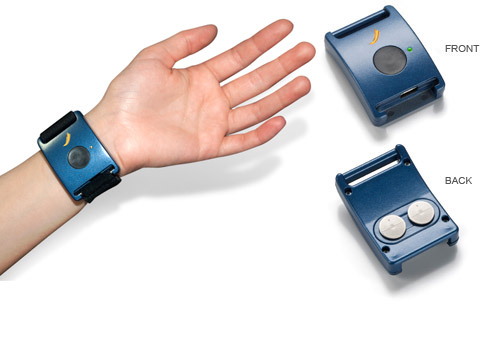How to measure emotions
July 6, 2011 by Amara D. Angelica

Q Sensor Curve is designed to wear on the wrist, so it is comfortable and unobtrusive to wear all day at work, play, or sleep. This makes it ideal for long-term measurement in clinical and therapeutic research. (credit: Affectiva)
Are you a geek who has trouble “reading” people? Now there new hope.
Research at the MIT Media Lab and the University of Cambridge to help people on the autism spectrum has spawned two new technologies to measure emotional response, along with a company called Affectiva to market them.
In the videos below, MIT’s Dr. Rosalind Picard demonstrates these technologies.
The Affectiva Q Sensor is a wearable, wireless biosensor that measures emotional arousal via skin conductance (aka galvanic skin response).
This is a form of electrodermal activity that grows higher during states such as excitement, attention or anxiety and lower during states such as boredom or relaxation. The sensor also measures temperature and activity.
Affectiva’s Affdex software can recognize emotions (or at least, outward expressions) from facial expressions and head motions.
Affdex detects anatomical facial muscle movements called action units and can characterize collections of those movements together with larger motions of the head such as nods or shakes.

Affectiva's Affdex software can recognize emotions. (credit: Affectiva)
Bayesian machine learning processes are used to combine the facial and head movements to recognize positive and negative displays of emotion as well as complex states such as interest and confusion.
Uses include market research, clinical research, artistic expression, biofeedback, performance of call centers, engagement measures, online gaming, learning style customization, nonverbal communication for nonspeaking people, robotics research, self-awareness enhancement, usability, and virtual reality research.
According to New Scientist, Affectiva has also developed glasses with a built-in camera to analyze facial six expressions: thinking, agreeing, concentrating, interested, confused, and disagreement.
The glasses contain a tiny camera connected to a wire snaking down to a dedicated smartphone-sized computer that runs Affdex software. The camera tracks 24 “feature points” on your conversation partner’s face, and software analyzes their myriad micro-expressions. It then compares that data with its bank of known expressions.
By sensing emotions that we would otherwise miss, this technology can thwart disastrous social gaffes and help us understand each other better, the researchers said.
Picard, R.W., “Emotion research by the people, for the people.” Emotion Review, Volume 2, Issue 3 (July 2010). PDF